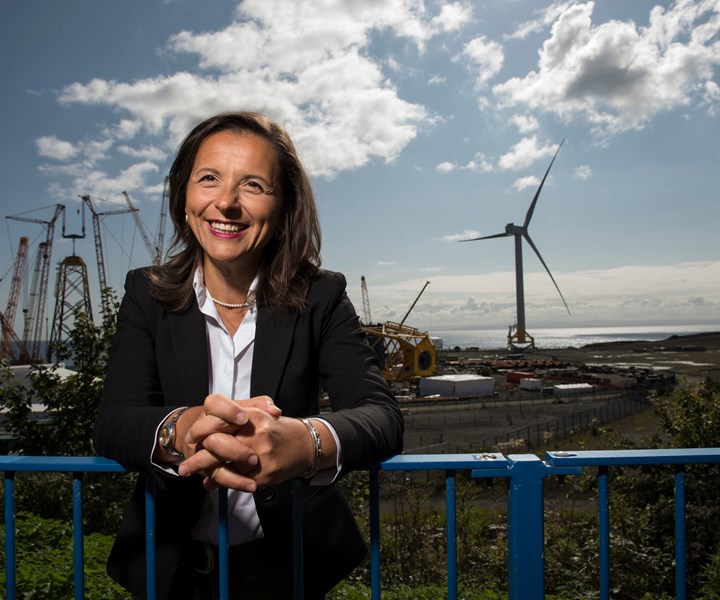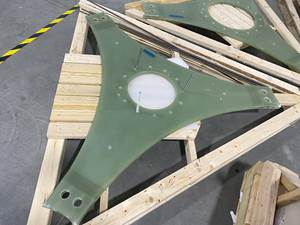ACT Blade, AMRC cooperate on 13m blade demonstrator
ACT Blade’s wind turbine blade design uses a textile shell overwrapping a structural spar to help reduce blade weight and manufacturing cost.

ACT Blade chief executive Sabrina Malpede. Source | ACT Blade
The Advanced Manufacturing Research Centre (AMRC) at the University of Sheffield (Sheffield, U.K.) reported on July 2 that has cooperated with ACT Blade (Edinburgh, Scotland) on the manufacture of a 13m wind turbine blade demonstrator that features ACT Blade’s new architecture that could substantially reduce blade weight and manufacturing cost.
The novel lightweight composite blade structure, which is wrapped in a textile shell, is up to a third lighter compared with typical fibreglass blade designs, can be made longer to generate more energy and, ultimately, has the potential to make offshore wind — already one of the cheapest major energy sources in the UK — even easier and cheaper to harness.
The first prototype produced under the Innovate UK-funded project was manufactured and tested in collaboration with a consortium of U.K. research partners that includes the University of Sheffield Advanced Manufacturing Research Centre (AMRC), the Lightweight Manufacturing Research Centre, sister centre to the University of Strathclyde’s Advanced Forming Research Centre (AFRC), both part of the National Manufacturing Institute Scotland, and the Offshore Renewable Energy (ORE) Catapult.
Dr. Sabrina Malpede, chief executive of ACT Blade, says, “The novel ACT Blade is a tensioned textile-covered wind turbine blade that can actively change shape to control loads. It is 32% lighter than conventional blades, enabling it to be 10% longer and directly contributing to the production of 9% more energy."
“The ACT Blade is not only the lightest but also the most modular blade,” said Dr Malpede. “That means we use components that can be manufactured in parallel, using smaller and therefore cheaper tooling, reducing costs by 60%. It also requires lower space — its factory will be 47% smaller than those of conventional blades — and lower energy which makes the manufacturing process less expensive compared with that of conventional blades.”
The AMRC’s John Halfpenny headed up the Sheffield team that worked on a 13m prototype blade alongside High Value Manufacturing (HVM) Catapult colleagues at the Lightweight Manufacturing Centre. Halfpenny, technical lead at the AMRC Composite Centre, says, “This is a completely new type of offshore turbine blade developed by ACT Blade that could be a major disruptor in the renewable energy sector.
Malpede adds, “As a micro-innovative start up, we have a small but highly competent R&D team in aerodynamic structure and composite design. As we were engaging with the engineering of the first prototype, we knew the AMRC was the right partner for us, providing the design for manufacturing support, assisting with advanced finite element analysis and, ultimately, supporting the manufacturing process.”
The AMRC undertook the crucial Finite Element Analysis (FEA) work to validate the new blade design. This allowed Halfpenny and his team to locate potential problems in the design, including areas of tension and weak spots, before producing CAD data to optimize the structural design of the prototype. They also designed patterns, molds and associated fixtures to manufacture the first blade.
Professor Iain Bomphray, director of the Lightweight Manufacturing Centre (LMC), is hosting the ACT Blade development, supporting the engineering and manufacturing of the new technology: “Wind energy is a natural energy source but even this clean energy source can be made even more sustainable still, by reducing the carbon footprint associated with the manufacture and transport of parts and by making the harnessing of the energy more efficient.
“The LMC was established as a center of excellence for innovative lightweight solutions, with the aim of helping manufacturing businesses large and small to overcome the challenges of the modern world. Our cross-Catapult collaboration working with ACT Blade on this exciting technology has allowed us to do exactly that.”
The UK is the world leader in offshore wind, with more installed capacity than any other country. Already, offshore wind powers the equivalent of 4.5 million homes annually and is set to power more than 30% of British electricity by 2030.
The 13m prototype was completed in February 2020 and testing began soon after with static tests completed at ORE Catapult’s National Renewable Energy Centre in Blyth in April. Results showed the blade could withstand extreme loads and every type of direction and twist, going beyond those predicted for an in-service turbine.
The blade is now undergoing further testing and in the coming months ACT Blade will work with the Energy Technology Centre to prepare for installation of three blades on a working wind turbine at the Myres Hill Wind Farm just south of Glasgow in Scotland.
Related Content
RTM, dry braided fabric enable faster, cost-effective manufacture for hydrokinetic turbine components
Switching from prepreg to RTM led to significant time and cost savings for the manufacture of fiberglass struts and complex carbon fiber composite foils that power ORPC’s RivGen systems.
Read MoreCollins Aerospace to lead COCOLIH2T project
Project for thermoplastic composite liquid hydrogen tanks aims for two demonstrators and TRL 4 by 2025.
Read MoreComposites end markets: Energy (2024)
Composites are used widely in oil/gas, wind and other renewable energy applications. Despite market challenges, growth potential and innovation for composites continue.
Read MoreAchieving composites innovation through collaboration
Stephen Heinz, vice president of R&I for Syensqo delivered an inspirational keynote at SAMPE 2024, highlighting the significant role of composite materials in emerging technologies and encouraging broader collaboration within the manufacturing community.
Read MoreRead Next
“Structured air” TPS safeguards composite structures
Powered by an 85% air/15% pure polyimide aerogel, Blueshift’s novel material system protects structures during transient thermal events from -200°C to beyond 2400°C for rockets, battery boxes and more.
Read MoreDeveloping bonded composite repair for ships, offshore units
Bureau Veritas and industry partners issue guidelines and pave the way for certification via StrengthBond Offshore project.
Read MoreVIDEO: High-volume processing for fiberglass components
Cannon Ergos, a company specializing in high-ton presses and equipment for composites fabrication and plastics processing, displayed automotive and industrial components at CAMX 2024.
Read More
























